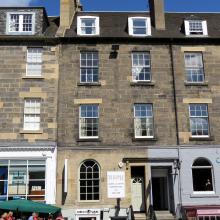
Ghost signs is the popular term used to describe those faded examples of hand-painted lettering found on buildings throughout the city.
Many date from the nineteenth century, and are interesting for the light they shed on the individuals who once occupied our streets with their more or less familiar busineses and occupations.
Spurtle noticed one such example between first-floor windows on Frederick Street last week, and decided to investigate. From the ground it is barely legible to the naked eye, but by manipulating the colour balance and contrast of a digital photograph one can just about decipher the following:
A strike aimed at reducing working hours from ten to nine hours was resolved through an agreement for a nine hour day, and the workers returned to work. However, they were only let on site if they signed an agreement to keep to the previous longer working hours. This resulted in over 1,200 stonemasons and joiners in Edinburgh being denied access to construction sites across the city for more than three months.
(The summary extracted above comes from an excellent study found on the Spokes website and also attached below.)

The Company was created as a joint-stock limited liability company and began by accumulating £10,000 for site and building costs by selling £1 shares (which could be bought in five instalments). The finished houses were to be sold or rented, allowing the Company to recoup money to invest in more housing and pay shareholders a dividend. The Company was considered a sound investment due to the shortage of good quality affordable housing. (ibid)
The tools of the various trades involved appear on the window keystones at the gable end of several terraces facing Glenogle Road.
A trawl through Edinburgh Post Office Directories shows that the ghost sign pictured above probably dates from around 1884, when the company moved to 13 Frederick Street from nearby premises at No. 29. Its manager is listed in the same entry as James Colville, one of the original subscribing stonemasons and the man for whom Colville Place was named in 1865.
Do you know of an interesting ghost sign in or around Broughton? Tell us about it, or send a photograph and we’ll do the research for you. You can contact us by email: spurtle@hotmail.co.uk or Twitter: @theSpurtle or Facebook: Broughton Spurtle
-------------------------
@theSpurtle an interesting story, one for @ghostsignsuk perhaps?

